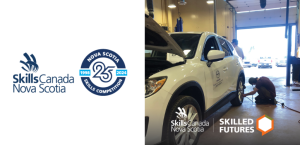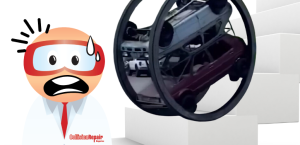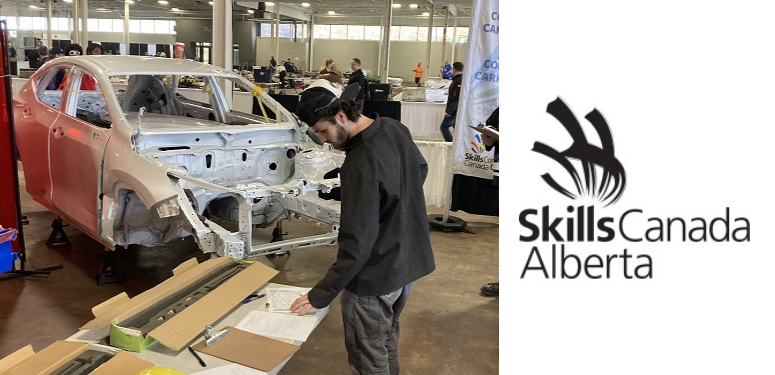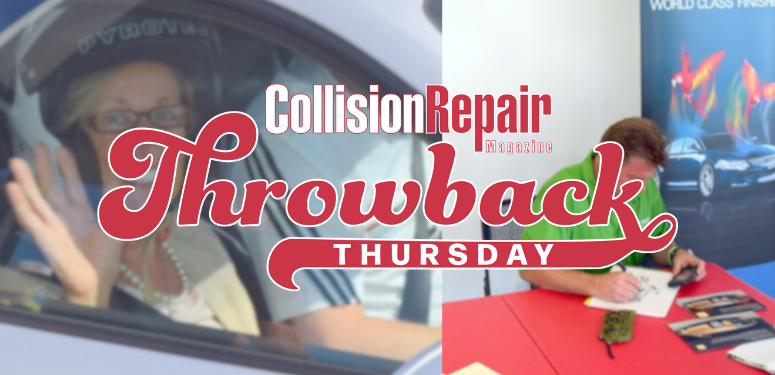By Jeff Sanford
Toronto, Ontario — April 2, 2017 — The Autonomous Report keeps you updated on all of the vital news on developments in autonomous vehicles (AVs). In this week’s edition, we look at two major announcements to come out of Canada in the last week, a timeline of AV development according to industry experts and much, much more!
– A couple of major announcements concerning AVs and the coming era of artificial intelligence-enhanced driving were made in Canada this past week. The first announcement came from Ford, which indicated, “it will spend as much as $337.9 million on a new research and development centre in Ottawa that will focus on developing self-driving vehicles … The new Innovation Centre plans to hire as many as 295 engineers, software developers and high-tech workers to help Ford design the next generation of autonomous cars,” according to a report by the Ottawa Citizen. It was only a couple months ago that BlackBerry announced a similar program in the nation’s capital. Blackberry is making a play in the AV space now that it has lost out on smart phones. Ford is said to be spending $1 billion on its Canadian facilities. The Feds will kick-in $102.4 million.
– The other announcement was made in Toronto, where the University of Toronto indicated it will set up The Vector Institute, “an independent non-profit that will hire 25 scientists to study Artificial Intelligence, “backed by more than $150 million in public and corporate funding in an unusual hybridization of pure research and business-minded commercial goals,” according to a report in the Toronto Star. “The province will spend $50 million over five years, while the federal government, which announced a $125-million Pan-Canadian Artificial Intelligence Strategy in last week’s budget, is providing at least $40 million, backers say. More than thirty companies have committed upwards of $80 million over 10 years, including $5 million each from sponsors including Google, Shopify, Loblaws, and several big banks, $2.5 million from a tier that includes Air Canada and Telus, and smaller commitments from a range of homegrown startups like FreshBooks and Deep Genomics.”
– Pictures surfaced this week of a horrific crash involving a Tesla. It’s amazing to think the driver made it out alive. He credited the, “vehicle’s safety for saving his life, but he also blamed the Autopilot for what he claims was ‘driving full speed into the back of a semi.’” The Model X involved was a P90D with “first generation Autopilot,” according to a story on Electrek. The owner of the Tesla involved in the alleged accident
supposedly had this to say: “There was a pickup truck that was out of gas in the right lane (lights were either dim or off, and given the
night, was hard to see). A semi was pulling up onto it, saw it, braked and swerved into my middle lane. Autopilot did not disengage, but did
the emergency beep about one second before impact. I was looking off to the side, and impacted the truck immediately after I heard the beep
and looked forward.”
The story notes that, “As usual, the driver is always responsible for monitoring the vehicle when Autopilot is engaged and should always be ready to take control. In this case, the driver admitted that he wasn’t looking forward at the time of the crash … The purpose of the Autopilot’s main feature, Autosteer, is to keep the vehicle in its lane, which is exactly what it did during the accident. What could have prevented or reduced the force of the impact are the Automatic Emergency Braking or Steering features, but they only engage if it’s the only option. In this case, it would have likely required to move to the left lane, which could have also been dangerous.” That is, “The ’emergency beep’ he referenced was the collision warning.”
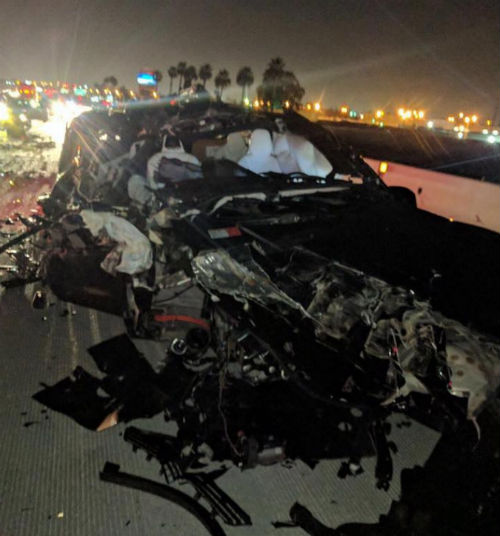 |
|
| The remains of another Tesla Autopilot crash. The driver made it out alive. |
– A story surfaced on the BBC this week about the difficulties of taking back control of an automated vehicle. The UK government is holding hearings on AVs. Professor Neville Stanton of the University of Southampton told the committee: “As vehicles become fully autonomous, even the most observant human driver’s attention will begin to wane … Their mind will wander … This is particularly true if they are engaging in other activities such as reading, answering emails, engaged in conversations with passengers, watching movies or surfing the internet.” Following on, it is said, “In general, research suggested drivers of automated vehicles were not as effective at dealing with emergencies as drivers of manual cars … For example, they had been found to take six times longer to respond to emergency braking by other vehicles.” The article goes on to state that, “Complacency could also negatively affect other road users, such as pedestrians and cyclists,” the Lords’ Committee said, adding that the government should give priority to research into people’s behaviour around autonomous vehicles.
– IBM has patented a machine learning technology that defines how to shift control of an autonomous vehicle between a human driver and a vehicle control processor in the event of a potential emergency. According to the story, “The system employs onboard sensors and artificial intelligence to determine potential safety concerns and control whether self-driving vehicles are operated autonomously or by surrendering control to a human driver … The idea is that if a self-driving vehicle experiences an operational glitch like a faulty braking system, a burned-out headlight, poor visibility, bad road conditions, it could decide whether the on-board self-driving vehicle control processor or a human driver is in a better position to handle that anomaly. If the comparison determines that the vehicle control processor is better able to handle the anomaly, the vehicle is placed in autonomous mode.”
– How fast will AVs happen? The trillion dollar question. Some say the changeover will happen with, “baby steps.” That is according to the co-founder of self-driving truck firm Otto. He’s been quoted as saying, “[It will first] happen in some friendly way to the city, with wide lanes, not many pedestrians, between 1am and 5am. Then it’s going to be actually [driving in] daylight. Then more difficult driving conditions.”Chris Urmson, one-time leader of the self-driving car project at Google, is quoted as saying this: “How quickly can we get this into people’s hands? If you read the papers, you see maybe it’s three years, maybe it’s 30 years. And I am here to tell you that honestly, it’s a bit of both.” The story goes on to rank various predictions from AV industry leaders:
2017: Elon Musk, CEO of Tesla, expects that this year, “A Tesla will drive in fully autonomous mode from LA to New York City.”
2020: Toyota assumes “vehicles to get on and off the highway and change lanes without driver input,” will happen by this point. Nissan thinks that AVs, “capable of navigating city intersections and heavy urban traffic without driver intervention,” will be on the road by this time.
2021: BMW expects that cars that can “drive on … highways and in urban environments,” will be on the road by this point. Ford expects, “high-volume, fully autonomous ‘level 4-capable’,” vehicles will be in commercial operation by this point. These cars, “will only be self-driving in the portion of major cities where the company can create and regularly update extremely detailed 3-D street maps.”
2026: Adrian Lund, President of the Insurance Institute for Highway Safety and the Highway Loss Data Institute, assumes that by this year, “a car with no steering wheel or pedals would make it a Level 5 automated vehicle [on the SAE International scale].”
2030: Kia thinks that in this year AVs, “that can pick you up without a driver and leave you somewhere else, without you necessarily having
to ever take control,” will be on the streets.
2032 to 2047: A Duke University researcher thinks a car that “operates by itself under all conditions, period,” will be on the road by this
point.
2035: Consultancy BGG thinks that, “12 million fully autonomous units [will be] sold a year globally.” Edwin Olson of the University of Michigan, thinks these cars are, “A ways off,” but that by this year there will be AVs on the road that, “can just put your kid in and ship off to school.”
– From an article in the most recent issue of Today’s Trucking magazine: “Autonomous vehicles won’t replace drivers – yet … The technology needed to create autonomous vehicles continues to move forward, but it could still be quite awhile before self-driving vehicles become an active part of the trucking industry.” The story goes on to note that, There are 1.8 million heavy truck drivers and 800,000 light truck drivers in the US. Note that a lot of the support system truck transport would still require humans, even if the trucks themselves don’t. “Many truck drivers and many support workers, mechanics and other administrative workers, they will continue to play an enormous role in this industry,” says a source quoted in the story. “Work that doesn’t involve driving won’t be as easy for robots to take over…The work of those non-driving tasks may shift elsewhere when trucks drive themselves, but it won’t disappear. Trucking jobs that don’t include driving at all. About 40 percent of those in the trucking industry aren’t truck drivers.”
-This week Cadillac shipped one of the first cars to be equipped with Vehicle-2-Vehicle capability. The new V2V communications technology,
“shares vehicles’ locations, speeds, directions and traffic conditions up to nearly 1,000 feet away.”
– A company named Starship Technologies is a London-based organization that “created six-wheeled self-driving delivery robots, will begin taking customers Domino’s pizzas in Germany and the Netherlands.” According to the founders of the company, the devices, “…will whisk pizzas to customers’ doors if they live within a one-mile radius of certain Dominos pizza shops in ‘select German and Dutch cities.’”
– Elon Musk has ruled out the idea that Tesla’s upcoming Model 3 will have a speedometer. “Replying to a query on Twitter, the Tesla CEO
said ‘no’ … reiterating his previous claims that Model 3 drivers won’t care about the speedometer thanks to the car’s high level of autonomy,” according to a report.
– A board member of BMW said this week that self-driving car technology will “outpace laws,” with cars able to make life or death decisions
within five years. Regulation on “deciding who is responsible for crashes will be unable to keep up.” According to Ian Robertson, “Autonomous vehicles will be capable of making decisions in the event of an accident that could result in life or death … But I don’t think we will reach a stage where regulation can match that.”




